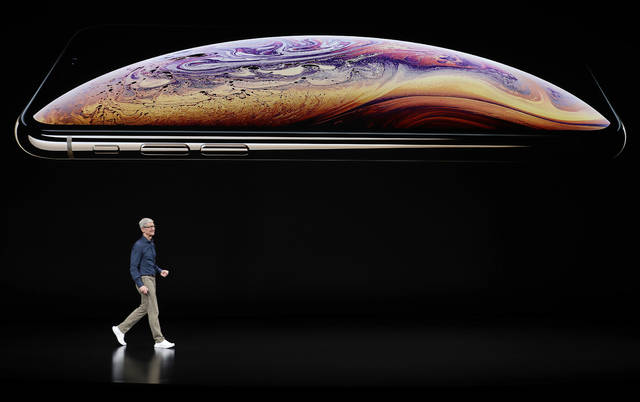CUPERTINO, California — Apple unveiled three new iPhones on Wednesday, including its biggest and most expensive model yet, as the company seeks to widen the product’s appeal amid slowing sales.
CEO Tim Cook showed off the Apple XS, which has a bigger screen than the one on last year’s dramatically designed model , the iPhone X. A bigger version will be called the iPhone XS Max, which looks to be about the size of the iPhone 8 Plus, though the screen size is much bigger.
As with the iPhone X, the new phone has a screen that runs from edge to edge, an effort to maximize the display without making the phone too awkward to hold. The screen needs no backlight, so black would appear as truly black rather than simply dark.
This even-bigger iPhone represents Apple’s attempt to feed consumers’ appetite for increasingly larger screens as they rely on smartphones to watch and record video, as well as take photos wherever they are.
The iPhone X also got rid of the home button to make room for more screen and introduced facial-recognition technology to unlock the device.
By making more expensive iPhones, Apple has been able to boost its profits despite waning demand as people upgrade phones less frequently. IPhones fetched an average price of $724 during the April-June period, a nearly 20 percent increase from a year earlier.
Apple also showed off a cheaper iPhone, called the iPhone XR. It is made of aluminum, and smaller than the iPhone 8 Plus in physical size, but has a bigger screen.
Worldwide smartphone sales grew just 2 percent during that period, according to the research firm Gartner Inc. During the second quarter, which is typically slow for Apple, China’s Huawei Technologies surpassed Apple as the second-largest seller of smartphones, based on Gartner’s calculations. Samsung remained in the lead.
Apple also announced updates that push its Apple Watch further into medical device territory. It has a larger screen and a built-in heart sensor that the company said can detect irregular heart rates and perform an electrocardiogram. The latter feature has been cleared by the U.S. Food and Drug Administration, the company said.
These features will be available to U.S. customers later this year, but Apple did not say when it would make it to the rest of the world.
In addition, Apple says the Series 4 Apple Watch will also be able to detect when someone falls — and can tell the difference between a trip and a fall. If it detects a fall and the user doesn’t respond in a minute, it’ll automatically call for help. This feature may be especially attractive to older people or those with elderly parents worried about falling when no one is around to help.
——
AP Technology Writer Barbara Ortutay contributed from New York.



